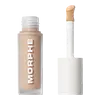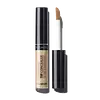What's inside
What's inside
 Key Ingredients
Key Ingredients

 Benefits
Benefits

 Concerns
Concerns

 Ingredients Side-by-side
Ingredients Side-by-side

Water
Skin ConditioningOctyldodecanol
EmollientPropanediol
SolventGlycerin
HumectantDiphenylsiloxy Phenyl Trimethicone
Skin ConditioningCoco-Caprylate/Caprate
EmollientSimmondsia Chinensis Seed Oil
EmollientPolyglyceryl-3 Polyricinoleate
EmulsifyingIsododecane
EmollientAcrylates/Dimethicone Copolymer
Skin ConditioningGlyceryl Caprylate
EmollientSorbitan Isostearate
EmulsifyingDisodium Stearoyl Glutamate
CleansingSodium Chloride
MaskingDisteardimonium Hectorite
StabilisingAluminum Hydroxide
EmollientPolyhydroxystearic Acid
EmulsifyingSodium Hyaluronate
HumectantAlgae Extract
EmollientArnica Montana Flower Extract
MaskingTocopherol
AntioxidantLeuconostoc/Radish Root Ferment Filtrate
AntimicrobialTremella Fuciformis Extract
HumectantPentylene Glycol
Skin Conditioning1,2-Hexanediol
Skin ConditioningFructose
HumectantUrea
BufferingCitric Acid
BufferingSodium Hydroxide
BufferingEthyl Hexanediol
SolventIpomoea Batatas Root Extract
Skin ConditioningHydroxyacetophenone
AntioxidantMaltose
MaskingSodium PCA
HumectantSodium Lactate
BufferingTrehalose
HumectantAllantoin
Skin ConditioningGlucose
HumectantTitanium Dioxide
Cosmetic ColorantCI 77491
Cosmetic ColorantCI 77492
Cosmetic ColorantCI 77499
Cosmetic ColorantWater, Octyldodecanol, Propanediol, Glycerin, Diphenylsiloxy Phenyl Trimethicone, Coco-Caprylate/Caprate, Simmondsia Chinensis Seed Oil, Polyglyceryl-3 Polyricinoleate, Isododecane, Acrylates/Dimethicone Copolymer, Glyceryl Caprylate, Sorbitan Isostearate, Disodium Stearoyl Glutamate, Sodium Chloride, Disteardimonium Hectorite, Aluminum Hydroxide, Polyhydroxystearic Acid, Sodium Hyaluronate, Algae Extract, Arnica Montana Flower Extract, Tocopherol, Leuconostoc/Radish Root Ferment Filtrate, Tremella Fuciformis Extract, Pentylene Glycol, 1,2-Hexanediol, Fructose, Urea, Citric Acid, Sodium Hydroxide, Ethyl Hexanediol, Ipomoea Batatas Root Extract, Hydroxyacetophenone, Maltose, Sodium PCA, Sodium Lactate, Trehalose, Allantoin, Glucose, Titanium Dioxide, CI 77491, CI 77492, CI 77499
Water
Skin ConditioningTitanium Dioxide
Cosmetic ColorantCyclopentasiloxane
EmollientPhenyl Trimethicone
Skin ConditioningTalc
AbrasiveButylene Glycol
HumectantCetyl PEG/PPG-10/1 Dimethicone
EmulsifyingPvp
Emulsion StabilisingCI 77492
Cosmetic ColorantPEG-10 Dimethicone
Skin ConditioningVinyl Dimethicone/Methicone Silsesquioxane Crosspolymer
Sodium Chloride
MaskingAluminum Hydroxide
EmollientTriethoxycaprylylsilane
Disteardimonium Hectorite
StabilisingStearic Acid
CleansingPhenoxyethanol
PreservativeCI 77491
Cosmetic ColorantChlorphenesin
AntimicrobialDimethicone
EmollientCI 77499
Cosmetic ColorantParfum
MaskingCalamine
AbsorbentEctoin
Skin ConditioningMannitol
HumectantYeast Extract
Skin ConditioningAlcohol
AntimicrobialCentella Asiatica Leaf Extract
Skin ConditioningGlycogen
HumectantMagnesium Ascorbyl Phosphate
AntioxidantAloe Barbadensis Leaf Extract
EmollientArnica Montana Flower Extract
MaskingGentiana Lutea Root Extract
Skin ConditioningAchillea Millefolium Extract
CleansingArtemisia Vulgaris Extract
Skin ConditioningGlycerin
HumectantPotassium Sorbate
PreservativeCitric Acid
BufferingSodium Benzoate
MaskingWater, Titanium Dioxide, Cyclopentasiloxane, Phenyl Trimethicone, Talc, Butylene Glycol, Cetyl PEG/PPG-10/1 Dimethicone, Pvp, CI 77492, PEG-10 Dimethicone, Vinyl Dimethicone/Methicone Silsesquioxane Crosspolymer, Sodium Chloride, Aluminum Hydroxide, Triethoxycaprylylsilane, Disteardimonium Hectorite, Stearic Acid, Phenoxyethanol, CI 77491, Chlorphenesin, Dimethicone, CI 77499, Parfum, Calamine, Ectoin, Mannitol, Yeast Extract, Alcohol, Centella Asiatica Leaf Extract, Glycogen, Magnesium Ascorbyl Phosphate, Aloe Barbadensis Leaf Extract, Arnica Montana Flower Extract, Gentiana Lutea Root Extract, Achillea Millefolium Extract, Artemisia Vulgaris Extract, Glycerin, Potassium Sorbate, Citric Acid, Sodium Benzoate
Ingredients Explained
These ingredients are found in both products.
Ingredients higher up in an ingredient list are typically present in a larger amount.
Aluminum Hydroxide is a form of aluminum. It can be naturally found in nature as the mineral gibbsite. In cosmetics, Aluminum Hydroxide is used as a colorant, pH adjuster, and absorbent.
As a colorant, Aluminum Hydroxide may add opacity, or reduce the transparency. Aluminum hydroxide is contains both basic and acidic properties.
According to manufacturers, this ingredient is an emollient and humectant. This means it helps hydrate the skin.
In medicine, this ingredient is used to help relieve heartburn and help heal ulcers.
There is currently no credible scientific evidence linking aluminum hydroxide in cosmetics to increased cancer risk.
Major health organizations allow the use of aluminum hydroxide in personal care products and have not flagged it as a carcinogenic risk at typical usage levels.
Learn more about Aluminum HydroxideArnica Montana Flower is more commonly known as Wolf's Bane. While this flower has been used in traditional medicine, its skin benefits are in question.
The FDA considers Wolf's Bane to be an unsafe herb. They advise against taking it orally or applying it to broken skin.
Wolf's Bane has been said to have anti-inflammatory properties. However, studies are conflicting about whether this is true.
According to the Final report on the safety assessment of Arnica montana, this plant has not been found to cause dermal irritation.
This flower contains numerous fatty acids such as palmitic, linoleic, myristic, and linolenic acids. The presence and amount of fatty acids depends on where the flower is harvested.
Like other flowers, this ingredient has a natural fragrance. It can also be used to mask, or cover, the unpleasant scents from other ingredients.
Learn more about Arnica Montana Flower ExtractCi 77491 is also hydrated iron III oxide. It's sole purpose is to give a red/pink hue to products.
Iron III oxides are classified as inorganic chemicals for coloring.
Synthetically created Ci 77491 is considered safer than those naturally found. This is because the synthetically created version may contain less impurities. Iron oxides are generally non-toxic and non-allergenic.
Learn more about CI 77491Ci 77492 is also hydrated iron III oxide. It's sole purpose is to give a yellow hue to products.
Iron III oxides are classified as inorganic chemicals for coloring.
Synthetically created Ci 77492 is considered safer than those naturally found. This is because the synthetically created version may contain less impurities. Iron oxides are generally non-toxic and non-allergenic.
Learn more about CI 77492Ci 77499 is also hydrated iron III oxide. It is created from mixing red and black iron oxides. This helps give shades of darkness to a product.
Iron III oxides are classified as inorganic chemicals for coloring.
Citric Acid is an alpha hydroxy acid (AHA) naturally found in citrus fruits like oranges, lemons, and limes.
Like other AHAs, citric acid can exfoliate skin by breaking down the bonds that hold dead skin cells together. This helps reveal smoother and brighter skin underneath.
However, this exfoliating effect only happens at high concentrations (20%) which can be hard to find in cosmetic products.
Due to this, citric acid is usually included in small amounts as a pH adjuster. This helps keep products slightly more acidic and compatible with skin's natural pH.
In skincare formulas, citric acid can:
While it can provide some skin benefits, research shows lactic acid and glycolic acid are generally more effective and less irritating exfoliants.
Most citric acid used in skincare today is made by fermenting sugars (usually from molasses). This synthetic version is identical to the natural citrus form but easier to stabilize and use in formulations.
Read more about some other popular AHA's here:
Learn more about Citric AcidDisteardimonium Hectorite comes from the clay mineral named hectorite. It is used to add thickness to a product.
It can also help stabilize a product by helping to disperse other ingredients.
Hectorite is a rare, white clay mineral.
Learn more about Disteardimonium HectoriteGlycerin is already naturally found in your skin. It helps moisturize and protect your skin.
A study from 2016 found glycerin to be more effective as a humectant than AHAs and hyaluronic acid.
As a humectant, it helps the skin stay hydrated by pulling moisture to your skin. The low molecular weight of glycerin allows it to pull moisture into the deeper layers of your skin.
Hydrated skin improves your skin barrier; Your skin barrier helps protect against irritants and bacteria.
Glycerin has also been found to have antimicrobial and antiviral properties. Due to these properties, glycerin is often used in wound and burn treatments.
In cosmetics, glycerin is usually derived from plants such as soybean or palm. However, it can also be sourced from animals, such as tallow or animal fat.
This ingredient is organic, colorless, odorless, and non-toxic.
Glycerin is the name for this ingredient in American English. British English uses Glycerol/Glycerine.
Learn more about GlycerinChances are, you eat sodium chloride every day. Sodium Chloride is also known as table salt.
This ingredient has many purposes in skincare: thickener, emulsifier, and exfoliator.
You'll most likely find this ingredient in cleansers where it is used to create a gel-like texture. As an emulsifier, it also prevents ingredients from separating.
There is much debate on whether this ingredient is comedogenic. The short answer - comedogenic ratings don't tell the whole story. Learn more about comegodenic ratings here.
The concensus about this ingredient causing acne seems to be divided. Research is needed to understand if this ingredient does cause acne.
Scrubs may use salt as the primary exfoliating ingredient.
Learn more about Sodium ChlorideTitanium dioxide is a mineral UV filter widely used in sunscreens and cosmetics.
It is one of only two UV filters officially classified as “mineral” by regulatory agencies, the other being zinc oxide.
Titanium dioxide provides broad-spectrum protection mostly in the UVB and UVAII range, with some protection in the UVAI range.
While its UVA protection isn’t as strong as zinc oxide’s, the difference is minor.
A common myth is that mineral UV filters reflect UV light. However, modern research shows titanium dioxide absorbs UV radiation like chemical filters (~95% absorption & 5% reflection).
Thanks to its non-irritating nature, titanium dioxide is suitable for sensitive, acne-prone, or redness-prone skin. It is unlikely to cause "eye sting" like other sunscreen ingredients.
A major drawback of this ingredient is its white cast and thick texture. This is why mineral sunscreens often leave a white cast and are less cosmetically elegant than chemical/hybrid sunscreens.
To improve white cast and spreadability, micronized or nano-sized titanium dioxide is often used.
There are ongoing concerns surrounding nano-titanium oxide's impact on marine ecosystems.
There is no conclusive evidence that any form of titanium oxide (or any other sunscreen ingredients) will cause harm to marine ecosystems or coral reefs. The science is still developing but many consumers are keeping a close eye on this issue.
Please note, many destinations have reef-safety sunscreen rules. For instance, the U.S. Virgin Islands advises all visitors to use non-nano mineral sunscreens.
Nano mineral sunscreens once raised safety concerns about absorption into skin.
Extensive research has shown that they do not penetrate healthy or damaged skin; they remain safely on the surface and the top layer of dead skin (stratum corneum).
You'll likely find titanium dioxide bundled with alumina, silica, or dimethicone. These ingredients help make titanium dioxide highly photostable; this prevents it from interacting with other formula components under UV light.
Learn more about Titanium DioxideWater. It's the most common cosmetic ingredient of all. You'll usually see it at the top of ingredient lists, meaning that it makes up the largest part of the product.
So why is it so popular? Water most often acts as a solvent - this means that it helps dissolve other ingredients into the formulation.
You'll also recognize water as that liquid we all need to stay alive. If you see this, drink a glass of water. Stay hydrated!
Learn more about Water